Victorian Horticulture Soils - Vertosols
Back to: Victorian Horticulture Soils
| Vertosols are clay soils (>35% clay throughout) that shrink and swell, and crack as the soil dries. Slickensides are often evident in subsoil horizons. Gilgai ('crabholey') microrelief is commonly associated with these soils. Vertosols often have self-mulching surfaces, although more coarsely structured surface soils also occur. Subsoils are often sodic and can be calcareous at depth, usually with visible free calcium carbonate (lime). Subsoil variability is often a feature due to the shrinking and swelling nature of these soils. | 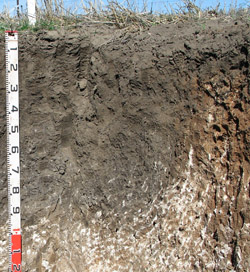 Grey Vertosol at Longerenong displaying considerable subsoil variability |
| In the Australian Soil Classification (Isbell 2002), Vertosols can be distinguished based on the nature of the surface horizon (e.g. Self-mulching, Epipedal, Crusty) and the colour and chemical properties of the subsoil horizons. Based on colour of the upper 50 cm of the soil profile, they can be grouped into suborders (Grey, Red, Brown or Black). | 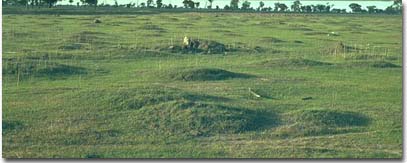 Gilgai microrelief in a paddock near Horsham |
| In the northern plains of Victoria, Grey Vertosols predominate on the large floodplains associated with the Murray and Loddon Rivers, whilst other streams have smaller occurrences. Vertosols also occur on plains in the Goulburn region but are not as dominant. Soil pit site LP101 is an example of a Brown Vertosol near Colbinabbin. Vertosols are a dominant soil in the Wimmera region where they typically occur on level to gently undulating gilgaied plains associated with parent sediments that are mainly alluvial and aeolian (windblown) clayey materials. Grey Vertosols are the most common, with minor occurrences of Red and Brown Vertosols. Self-mulching Vertosols are common in the Horsham and Kaniva regions. Soil pit site WCSS3 is an example of a Grey Vertosol at Longerenong. Self-mulching Black Vertosols, with peaty sub-surface horizons, that have developed on former swamp deposits near Koo-Wee-Rup, are extensively utilised for horticulture. Soil Pit Site GP23 is an example of a Black Vertosol near Cardinia. | 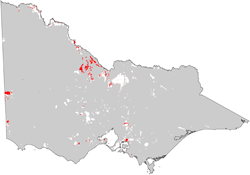 |
Management Considerations
The surface of Vertosols can often be sodic and disperse significantly after remoulding. This indicates that tillage or overstocking of the soil whilst in a moist to wet condition may result in structural degradation (e.g. surface sealing, increased cloudiness, pugging) occurring. Gypsum application may assist in improving surface soil structural condition on such soils. The subsoil can often be sodic and coarsely structured, which will restrict root and water movement. Waterlogging is likely in wet seasons.
The subsoil of Vertosols displays strong vertic properties (as evidenced by the presence of slickensides and significant cracking) which indicates that significant shrinking and swelling occurs with wetting and drying cycles. This may disturb the roots of some perennial plant species and has engineering implications (e.g. disturbance to building foundations and fencelines).
The surface condition of Vertosols is an important management consideration. Epipedal and self-mulching Vertosols differ with respect to surface soil friability, pH, profile salinity and clay mineralogy. Self-mulching Vertosols are most suited to horticulture as they are more friable and easy to work and provide favourable seedbed conditions. Epipedal Vertosols have coarser structured and more dense surface horizons.
High clay soils have a high wilting point value, indicating that plants will not be able to fully utilise light rains falling on relatively dry soil, as there will be insufficient moisture to wet the soil above the wilting point. When the soil is dry, heavy rains will move down soil cracks. This rapid recharge can be valuable for the survival of plants near wilting. When wet, the soil will swell and further infiltration of water will be relatively slow.
Physical disturbance of cracking clay soils should be avoided if the soil is wet (i.e. wetter than the plastic limit). At such moisture conditions, tillage or excessive trafficking or overstocking could result in structural damage (e.g. compaction, smearing) occurring. Ideally, tillage and trafficking should take place on cracking clay soils when the soil is drier than the plastic limit, down to at least the tillage depth. See Compaction in the Soil health section of the VRO website.
Subsoils of Vertosols can often be strongly alkaline, particularly in northern Victoria and on some soils developed on basalt in south-west Victoria. This indicates that phosphorus and some trace elements such as iron, manganese, zinc and copper may be poorly available to plants and deficiencies may occur. Deficiencies can be determined by plant tissue analysis. Boron toxicity can also occur in strongly alkaline soils.
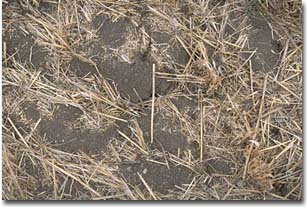 Self-mulching surface condition | 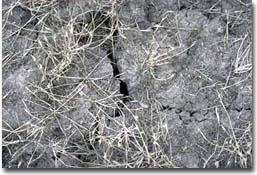 Epipedal surface condition |
Black Vertosols
Black Vertosols in the Koo-Wee-Rup district are strongly acid and can have very high levels of exchangeable aluminium. Aluminium becomes more soluble in soils at low pH levels. This is likely to restrict the growth of aluminium-sensitive plant species. High levels of aluminium will also tend to 'fix' phosphorus and make it less available to plants (and reduce the effectiveness of applied P fertiliser). Raising the pH level of the soil by liming will help reduce the level of exchangeable aluminium. A lime test (sampled across the paddock) may be appropriate to determine the amount of lime needed to raise pH levels. Other factors need to be considered, however, before lime is recommended (e.g. species grown, method of application, local trial responses, likely cost-benefit). Many vegetables have a preferred pH range beginning above 5.5, although potatoes have a preferred range of between 5.0 - 6.0. The relatively high levels of organic matter in these soils may assist in reducing the effects of aluminium on plants. Organic materials have been known to be effective in reducing the level of active aluminium in soils (Vimpany 1990).
Manganese toxicity can occur in strongly acid soils, especially when waterlogging occurs. Susceptible crops include cabbage, cauliflower, lettuce, celery and lucerne (NSW Dept. Agric. 1986). Raising the pH by lime application will assist in reducing any manganese toxicity.
A soil pit or spade hole provides an opportunity to assess whether there is any structural damage due to compaction. Signs of degraded structure to look out for include: lack of natural shiny-faced peds; development of coarse cloddy structure with 'flinty' appearance; presence of platy type structure, and distorted root growth. Degraded structure is usually evident in the 10-30 cm zone. Structural degradation will result in root movement being more restricted in the upper subsoil.
The upper subsoil is usually still strongly acid, and as a result exchangeable aluminium levels can remain high. Lime application at the soil surface will not significantly affect pH levels in the subsoil.


